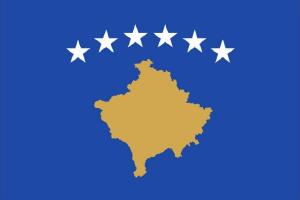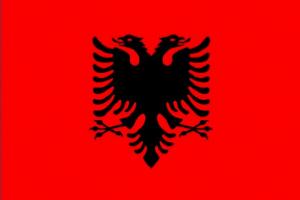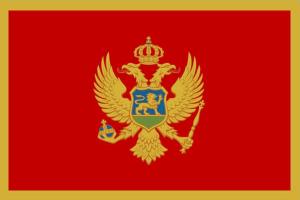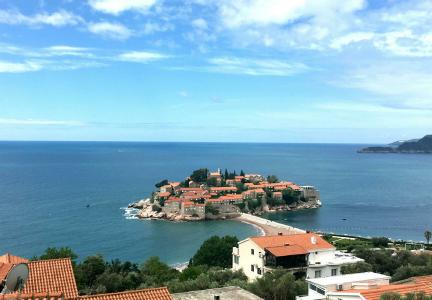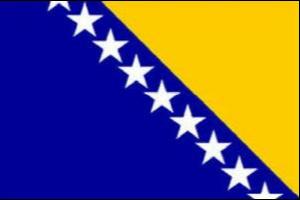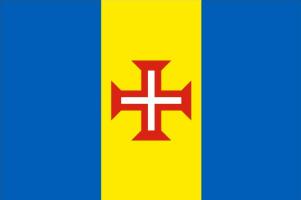The Balkans − May 31, 2019
In late 1981, I passed briefly through Yugoslavia,
en route from Athens to Venice.
In freezing rain, my bus broke down in the middle of nowhere.
I took refuge in a local militia's hangout, which served hot food and cold beer.
Some of you know the story of how I managed not to get killed that night.
But I never saw much of Yugoslavia because my bus was repaired before dawn and I was on my way to Italy.
Now, I'm pleased to return to a region that I've often wondered about −
and to be here at a time of year when there's no freezing rain.
The former Yugoslavia is now six sovereign states − seven, if you count Kosovo.
Throw in Albania, Greece and Bulgaria and you've got the Balkans.
I've been to Greece and Croatia, and loved both of those countries.
This time around, I want to see everything that I missed the first time that I was here almost 40 years ago.
I scored a bargain flight from Tajikistan to Istanbul.
From Istanbul, a luxurious train took me to Sofia, Bulgaria.
(I love trains!)
For the next few weeks, I'm resolved to travel by buses, trains, cars, bicycles and boats − anything but airplanes.
I'll see more that way.
Still, this tour of the Balkans won't be long enough to really get to know all these countries.
I just hope that I can get a good enough taste of what's here so that I'll know where to go and what to do when I come back here again.
|
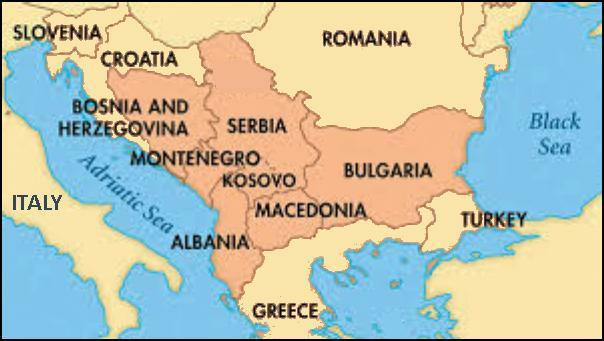
|
Although these countries have recovered from the end of the Soviet era and from the Balkan wars of the 90s,
tourism isn't fully developed here ... yet.
The locals are friendly.
They're happy to see visitors.
Prices are low.
My first impression of this area is that the Balkans are like Europe of the 70s −
which can be a very good thing.
|
Of these countries, only Bulgaria is part of the EU.
Most of these countries have their own currencies, which sharpens my math skills (ha!)
and ensures that I'll have some new additions to my currency collection.
|
|
|
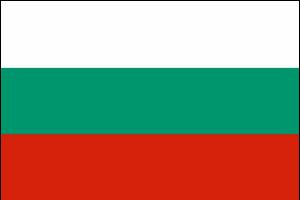
|
Bulgaria
| Population |
7 million |
| As big as |
Virginia |
| Capital |
Sofia |
| History |
A Roman regional capital |
|
If you like history and culture, you'll love Bulgaria's capital city, Sofia.
The area around Sofia has been inhabited for thousands of years.
Fertile soils and natural hot springs drew the first inhabitants here.
The Thracians lived here during the Bronze Age.
In 29AD, the Romans founded the city of
Serdica here and made it one of their regional capitals.
The city was an important trading post on the Silk Road.
To the Byzantine Empire, Sofia was second only to Constantinople.
|
|
Archaeologists have been busy here.
Sofia's Archaeological Museum contains 6000-year-old treasures.
Even more impressive is the Roman city of Serdica right in the center of Sofia.
Serdica's ruins were found during construction of Sofia's metro system in 2010-12.
When you ride Sofia's subway, you walk past 2000-year-old stone walls on the way to your train.
It's like a time machine to step from a Roman city onto a 21st century train.
Because of
its location between Europe and Asia,
and its significance to the Roman, Byzantine and Ottoman Empires,
Sofia has inherited a rich cultural mix
with mosques, synagogues and churches throughout the city.
The oldest church dates to the 4th century.
The most famous is the Aleksander Nevski Church, a neo-Byzantine masterpiece and a symbol of Bulgaria.
Walking around the city,
I was wowed by all the stunning gold-domed Orthodox cathedrals.
|

Aleksander Nevski Church
|

Interior of Sveta Nedelya Cathedral with its Byzantine murals, 1882-1912
|
Sofia's cathedrals are revered sites to which pilgrims make long treks, light candles, burn incense and give offerings.
The interiors of these cathedrals are cavernous.
Without pews or benches, they're particularly spacious.
As you can see from the photo on the left,
on a sunny day, smoke from the candles and incense is illuminated by shafts of light from the stained glass windows,
creating a ghostly and mystical atmosphere.
|
|
It took me two full days to see just half of Sofia's museums. Whew!
In one museum, I learned that the city's name comes from one of its oldest churches called Sveta Sofia,
who was the goddess of wisdom and fate.
Does this mean that people were wise to follow their fate and to settle here?
There's a 24-meter tall monument to Sofia in the middle of the city.
By day, I played tourist,
walking around,
gaping at the beautiful old buildings and
admiring the treasures in the handsome museums.
When the museums closed, it was time to find a delicious meal − which was easy to do.
|

Sofia History Museum, formerly a Turkish Mineral Baths
|

Boulevard Vitosha, a pedestrian walkway
|
Through the middle of downtown is a wide pedestrian mall lined with cafés.
Having just come from Iraq and Pakistan, I had wine with every dinner.
On clear evenings, I sipped fine local reds while gazing at snowcapped peaks framed by flowering trees.
It's a good life!
|

Authentic Bulgarian cuisine at the Manastirska Magernitsa
|
|
I spent four nights in Sofia and made the most of the arts scene.
I attended
Beethoven's 9th,
Madame Butterfly,
An Ideal Husband by Oscar Wilde,
and
an art opening.
Every event was held in an elegant state-owned theatre or hall.
Good seats never cost more than $20.
Naturally, every event was sold out.
I admire the way that the former Soviet republics continue to support and subsidize the arts.
|

|
North Macedonia
| Population |
2.1 million |
| As big as |
Vermont |
| Capital |
Skopje |
| History |
Alexander the Great and Mother Teresa born here |
|
From Sofia, I took a bus over the hill to Skopje in North Macedonia.
I thought the name of this country was just Macedonia.
But no.
In February 2019, in order to avoid confusion with the province in Greece called Macedonia,
this little country was required to change its official name from
Former Yugoslav Republic of Macedonia (abbreviated as FYROM) to North Macedonia.
What a mouthful.
Alexander the Great and Mother Teresa would never have agreed to say "Hi, I'm from FYROM."
|
|
What I found in North Macedonia was a peculiar surprise.
In 1963, a major earthquake leveled Skopje.
Still under the influence of the USSR at that time,
the city government opted to rebuild the city with a utilitarian and efficient style called
Brutalism,
under the direction of an architect named
Kenzo Tange.
The result of Tange's work was a dramatic cityscape which reflected the streamlined look of the 60s.
Click
here
to see what Skopje used to look like.
In 2010, Skopje's government decided that it was time for a major makeover.
They refaced many of Kenzo Tange's buildings,
and built 20 new buildings and 40 monuments along the river.
The makeover is staggering and a bit bizarre.
Now, instead of looking like something from the 1960s, Skopje looks like something from 60AD.
|

Skopje's riverfront and the Archaeology Museum
|

Hotel Senigallia in the Vardar River
|

Alexander on his horse
|
Skopje's wacky architecture isn't limited to the public buildings.
Check out the Spanish-galleon-themed hotel where I stayed,
in the photo above.
This city is a walk-through art gallery, museum, restaurant and casino.
Totally kitsch.
I'm not sure that Mother Teresa or Alexander the Great would approve, but the city had to do something after the earthquake in 1963.
Fortunately, some parts of Skopje have not been made over in Romanesque style.
The old Turkish bazaar still has the narrow cobblestone streets and colorful shops that it had in the Ottoman times.
|

Historic Čaršija (Old Turkish Bazaar)
|
|
North Macedonia's special distinction is that,
unlike its six neighbors to the north,
Macedonia managed to become independent from the former Yugoslavia
without bloodshed.
Consequently, this little country is the most relaxed and peaceful of the Balkan states.
|

Statue of Bill Clinton
|
Americans are loved here.
Kosovo might be the
most pro-American country in the world.
It all started in 1999 when the US-led air strikes routed the Serbian army and paved the way for Kosovo's independence.
Now, there are boulevards named Bill Clinton and George W. Bush (spelled Xhorxh Bush).
Even Bob Dole has his own street.
American flags are flown everywhere.
One of the most common names for girls under 20 is Hillary.
When Kosovars found out that I'm American, I was given VIP treatment.
I happened by the archaeological museum at the Prizren fortress.
At first, I was told that the museum was closed for renovation.
But everything changed when the staff heard my American accent.
|

A friendly café / bar in Pristina
|

Picturesque Prizren's Old Town by the Lumbardhi River
|
The museum director came out of his office to give me a special free tour of the archaeological dig
and of his museum.
Kosovo was an easy place to visit and a hard place to leave.
|

Reconstructing an Ottoman urn at the museum
|
|
Prizren gets my vote for being the prettiest, friendliest little town I visited on this whole trip.
One of the nice things about not booking everything in advance is that it's easy to change plans.
One morning, I asked my pension if I could stay an extra day or two.
No problem! ... and so I did.
|

Skënderbeg, Albania's 15th century hero
|
Albania has replaced its statue of Joseph Stalin with a more appealing historical figure:
A king named Skënderbeg who fought against the Ottoman empire.
He now gives his name to Tirana's main square.
State-owned stores have been replaced by
restaurants,
cafés
and
private enterprises.
I only spent 24 hours in Albania's capital but it was a fun and friendly day.
|

Carousel in Sheshi Skënderbeg Square
|

A bunker in the middle of downtown Tirana
|
One oddity about Albania is its 1000s of bunkers, leftover from its very cold war with the rest of the world.
These concrete mushrooms, designed
by former President Enver Hoxha
to protect him and his friends in case of nuclear war, are impossible to destroy.
So they've been converted into museums, bars and even a hotel.
My main reason for visiting this country was to see the Albanian Alps,
also known as the Accursed Mountains.
|

Click this photo to see the 10-car ferry on this lake
|

Crystal clear mountain streams
|
Getting to the Accursed Mountains in northern Albania required three buses, two days and a scenic 3-hour ride on the
Lake Koman Ferry.
From the final ferry dock at the top of the lake, a van took me to a valley that reminded me of Yosemite NP.
From there, trails lead up and over passes in all directions.
Did you know that Albania has high mountains, crystal clear mountain streams and real wilderness?
I sure didn't.
It won't be long before this secret gets out.
|

The trail from Valbona to Theth
|
|
Albania impressed me.
Of all the countries that I visited in the Balkans,
this is the country that I'm most likely to return to.
I'd like to do some more trekking in these gorgeous mountains.
|
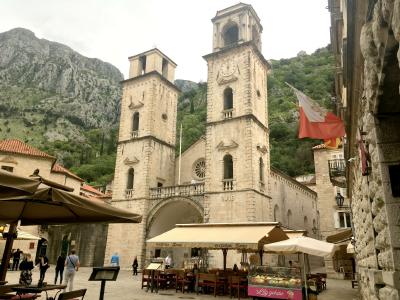
12th century Cathedral of Saint Tryphon in Kotor
|

The summer season on Mogren Beach at Budva (near Kotor)
|
|
Kotor is a place for wandering through narrow cobblestone streets,
visiting a museum and a cathedral or two,
and finding the perfect spot for wine, salad and seafood pasta,
while being serenaded by a guitar or a violin.
The best time for dinner is about 10 pm,
after the crowds return to their cruise ships.
|
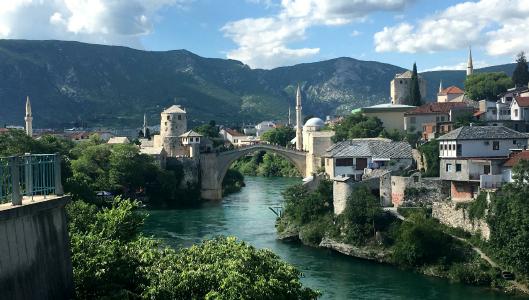
The restored town of Mostar and its famous bridge
|
I visited two cities heavily damaged by the war:
Sarajevo and Mostar.
The historic sites have been restored.
Survivors have begun new lives, and are ready to welcome visitors.
|
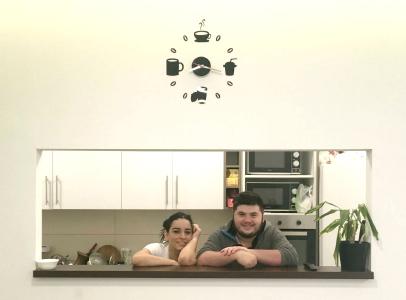
Amela and Mohammed who made my breakfasts
|
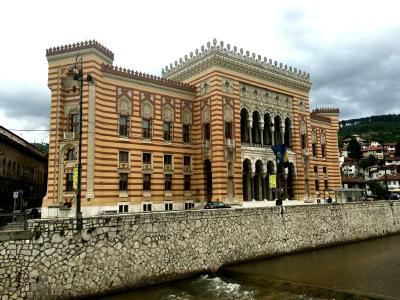
Restored City Hall in Sarajevo
|
Something that I find fascinating is how every country tells its own version of history.
In the western media, I remember reading that the Bosnia war (1992-95) was an "ethnic" conflict.
But that's not what a Bosniak will tell you.
Although there are religious differences throughout the Balkans,
Croats, Serbs and Bosniaks all have the same ethnicity: They are Slavs.
Bosnia has been a mixed society of Christians and Muslims for centuries.
Bosnia is content to remain mixed.
To the Bosniaks, the wars in the 90s were attempts by Croatia and Serbia to use religion as an excuse to claim parts of Bosnia's territory.
|
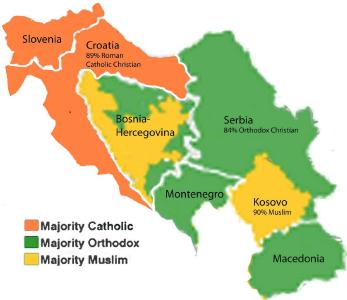
Simplified map of Balkan religious diversity
|
|
Bottom line: If you're ever in the Balkans, don't hesitate to visit Bosnia & Herzegovina.
This is a charming and hospitable country.
|
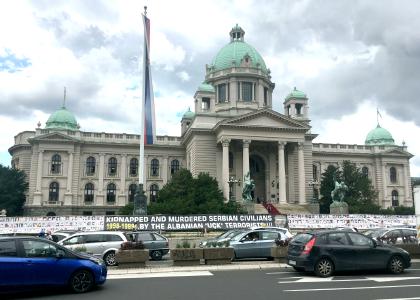
Signs of lingering discontent with the neighbors
|
As I walked around Belgrade, visiting museums and chatting with folks who live here,
I got the feeling that Serbs are nostalgic for the decades when Tito commanded a great nation.
Tito is revered,
with statues of him throughout the city.
Meanwhile, in parks and on boulevards, there are banners protesting against the provinces that broke away from the former Yugoslavia.
Serbia still doesn't recognize Kosovo as a country.
Serbia has its own version of history, too.
In Bosnia, at the
Sarajevo Assassination Museum,
I learned about the Serb who started World War I.
In contrast, the World War I museum in Belgrade explains that the war started when Austria invaded Serbia,
with no mention of the
assassination of Archduke Franz Ferdinand
by a Serb.
|
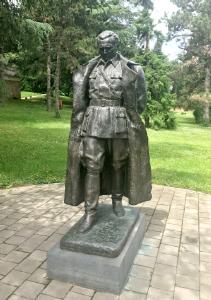
One of many Tito statues
|
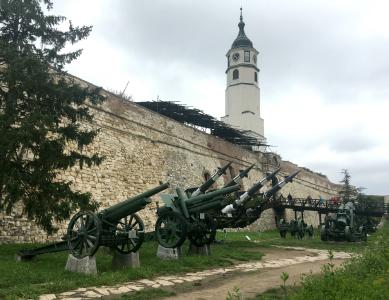
15th century walls and 20th century weapons
|
Still, life goes on.
Belgrade retains much of its former glory as one of Europe's elegant and notable cities.
This is a very pedestrian-friendly city.
The city's center is a huge pedestrian zone of about 1 square kilometer.
The main street,
Knez Mihailova,
is lined with ornate 19th century mansions built when Belgrade was part of the Austro-Hungarian Empire.
Knez Mihailova has been named one of the most beautiful pedestrian zones in Europe,
and is a common meeting point for Belgraders.
Full of restaurants and cafés,
it's a great place for striking up a conversation with someone at a nearby table or just people watching.
I confess that, in my three days in Belgrade, I spent about twelve entertaining and relaxing hours here.
What a great place to discuss the world's problems and to formulate solutions!
|
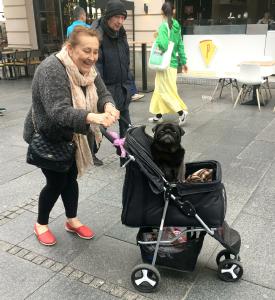
A woman walking her "baby"
|
 Sunset view of the Sava and Danube Rivers from the Belgrade Fortress
Sunset view of the Sava and Danube Rivers from the Belgrade Fortress
With sunset over the Danube, I'll end this long chapter.
I've seen 7 countries in 25 days.
If I'd been traveling through a single country, e.g. Yugoslavia,
I might feel as though I'd done a pretty good job seeing the whole country.
Instead, I feel as though I've barely scratched the surface of seven remarkable and unique nations.
Travel here has been easy.
Prices are low.
People are friendly.
English is spoken almost everywhere.
Since it's not summer yet, I haven't worried about finding a seat on the bus or a room in a hotel.
I love traveling spontaneously, without booking tickets or accommodations in advance.
That's how we all bummed around Europe 40 years ago.
It's wonderful that there's a region where this travel style still works.
The only thing that bugged me about the Balkans is that everyone smokes everywhere.
Many restaurants don't have non-smoking areas.
This will all change when − and if − these countries join the EU.
By then, more tourists will have discovered the Balkans ...
and maybe then the Balkans won't feel like "old Europe" any more.
This is true for many parts of the world,
which is why I frequently give this advice:
See the world now, before it all changes!

|
|







































































 US Dollar Exchange Rate
US Dollar Exchange Rate










